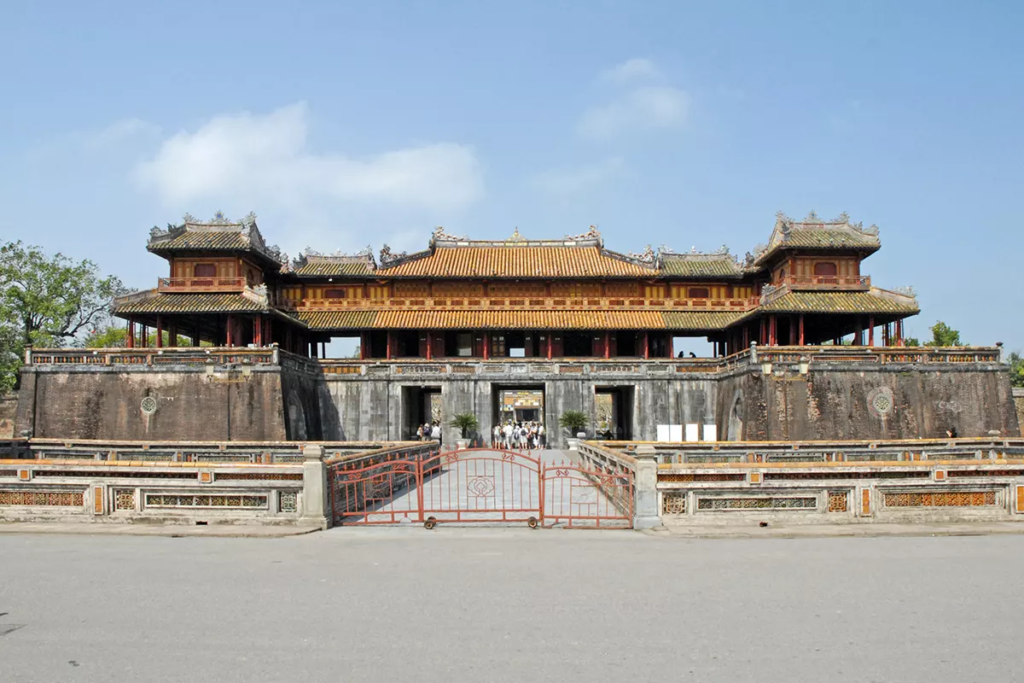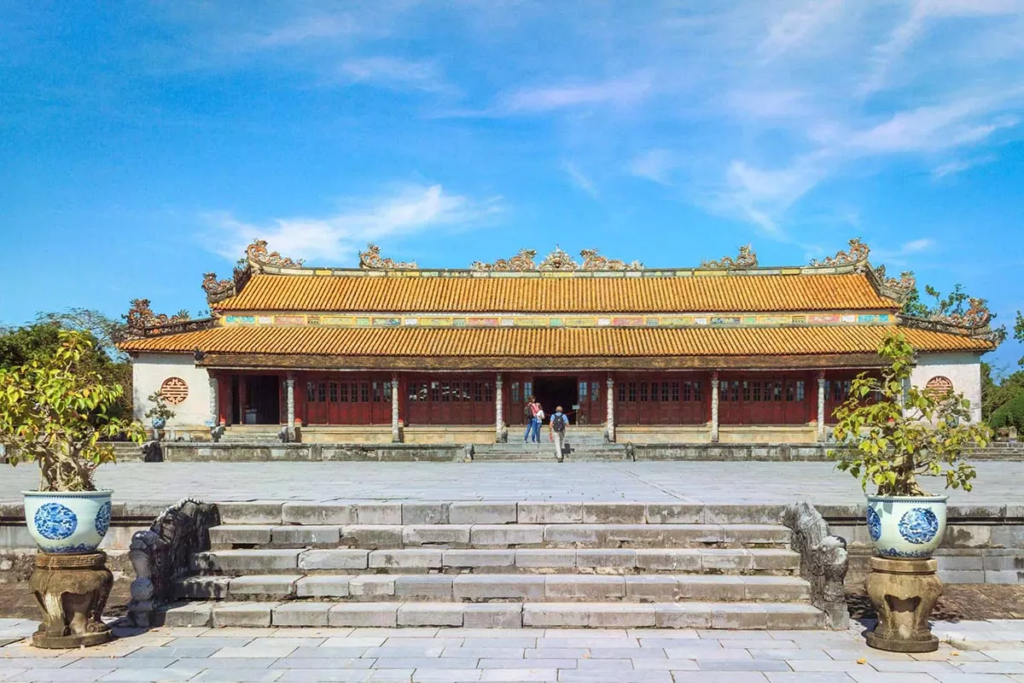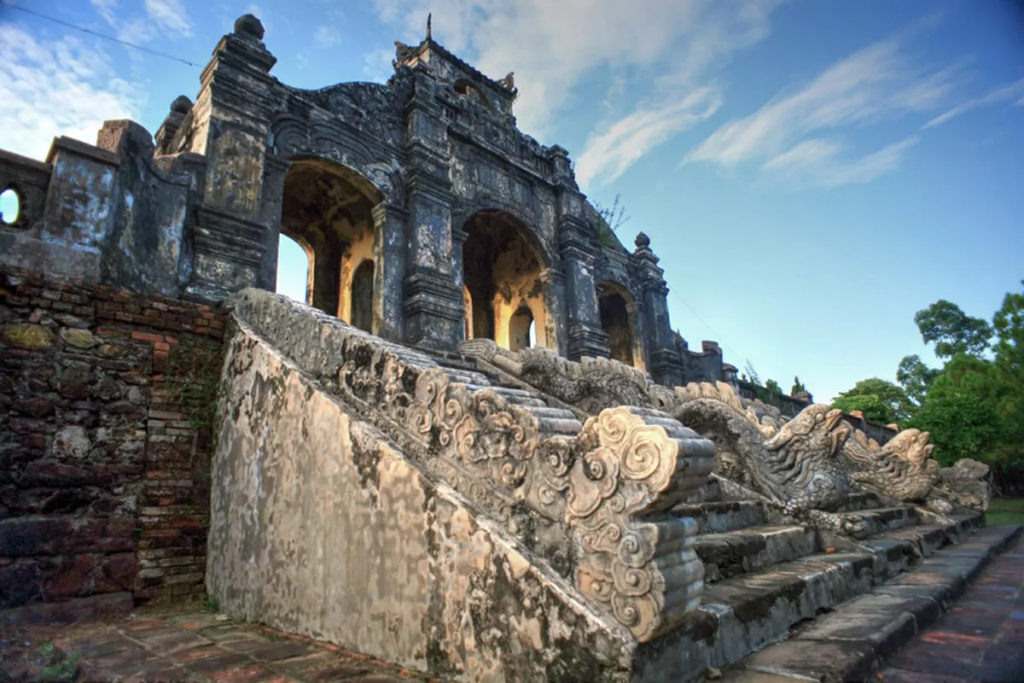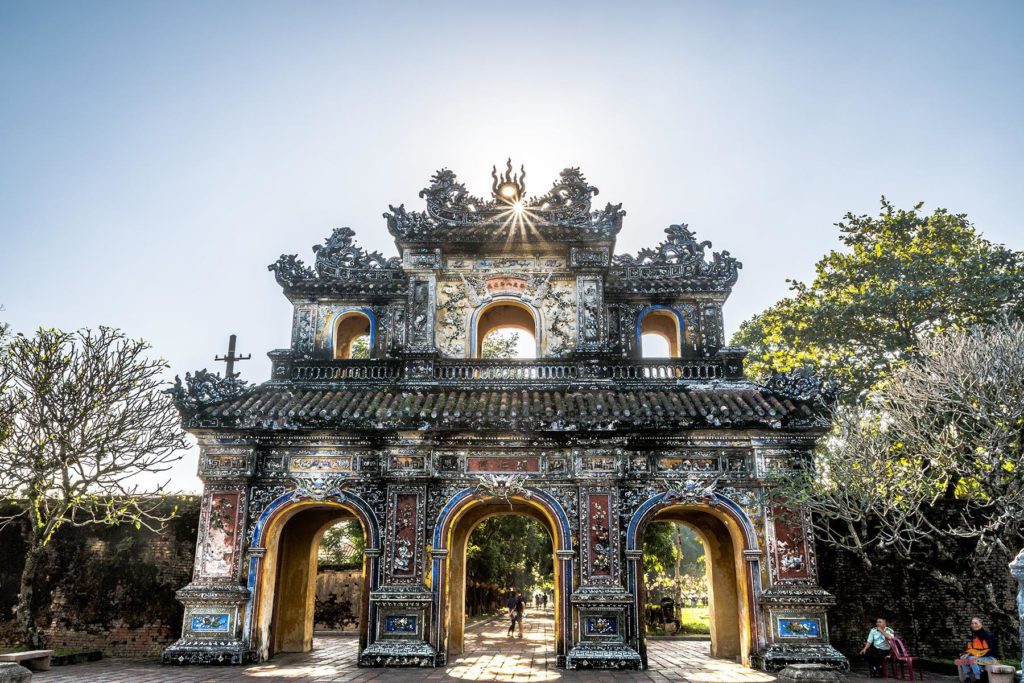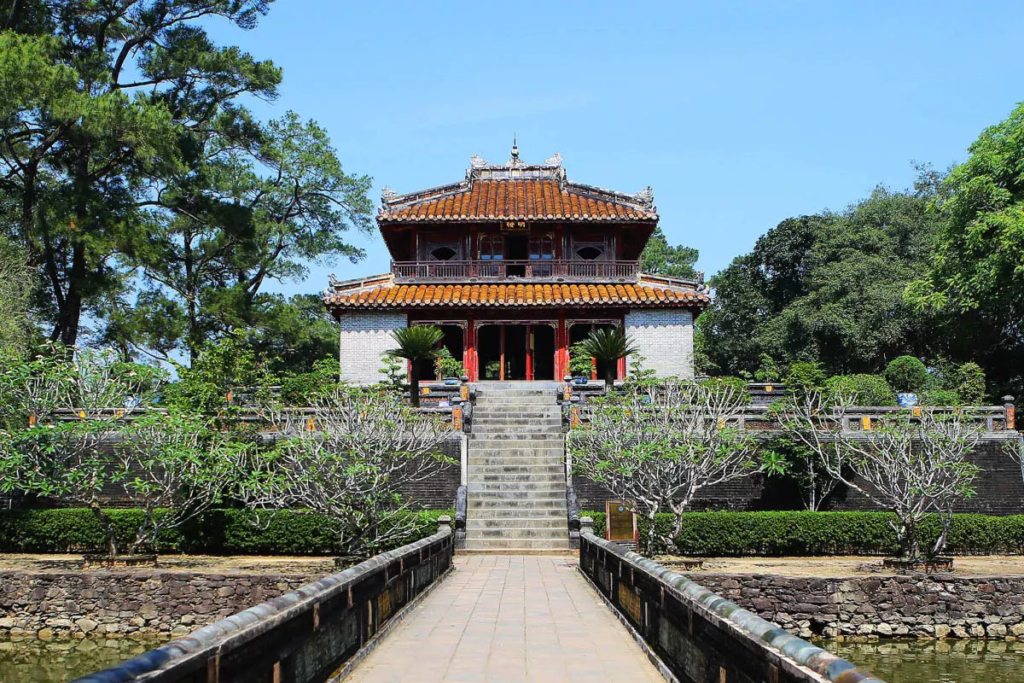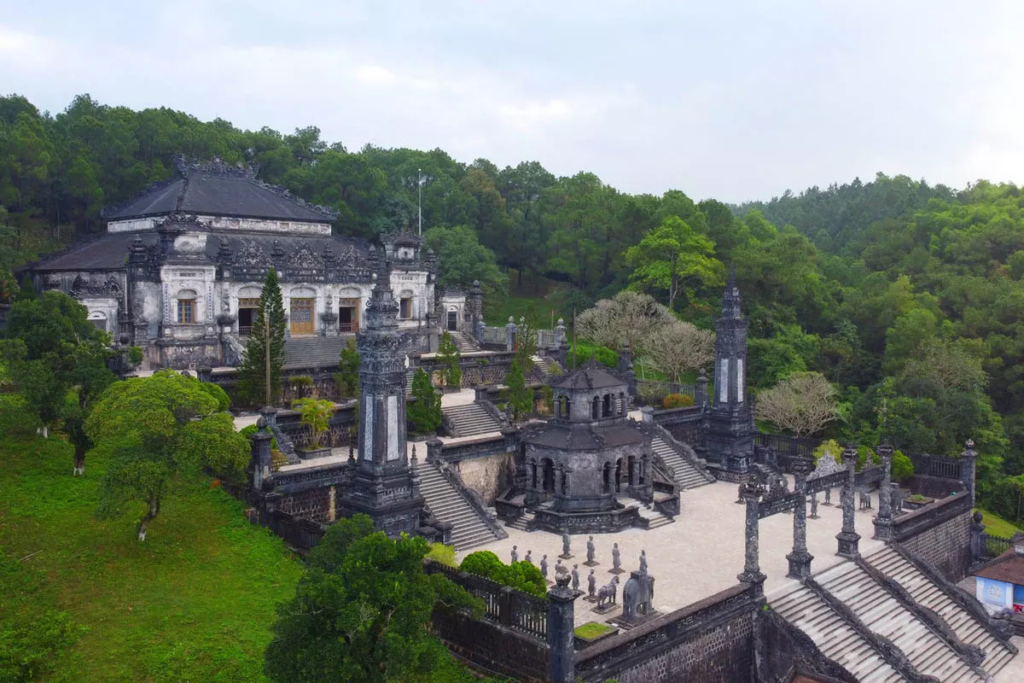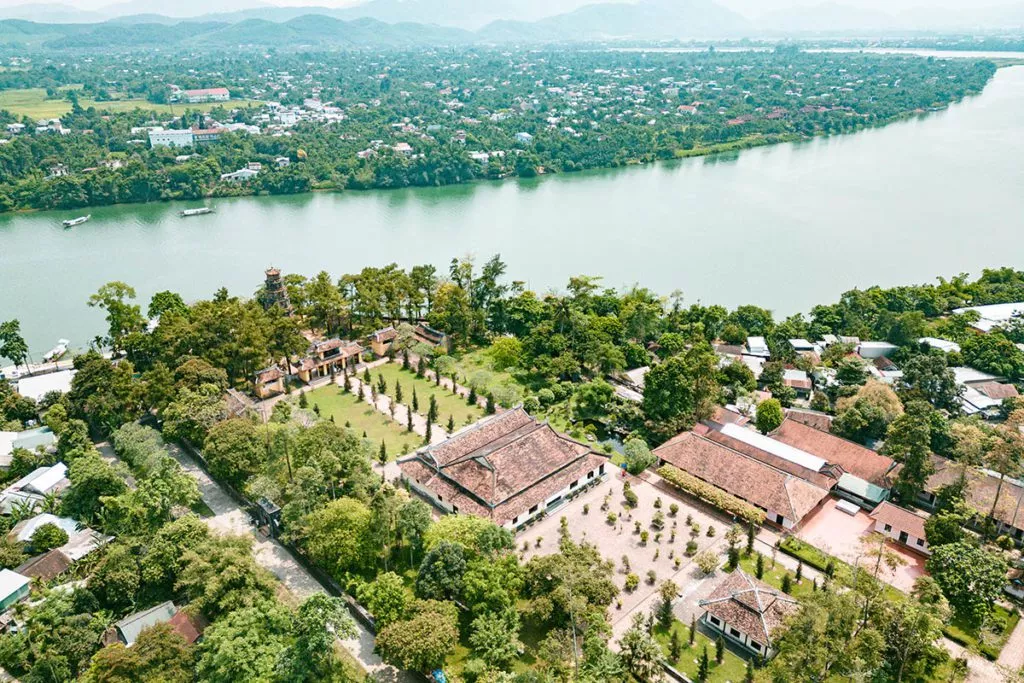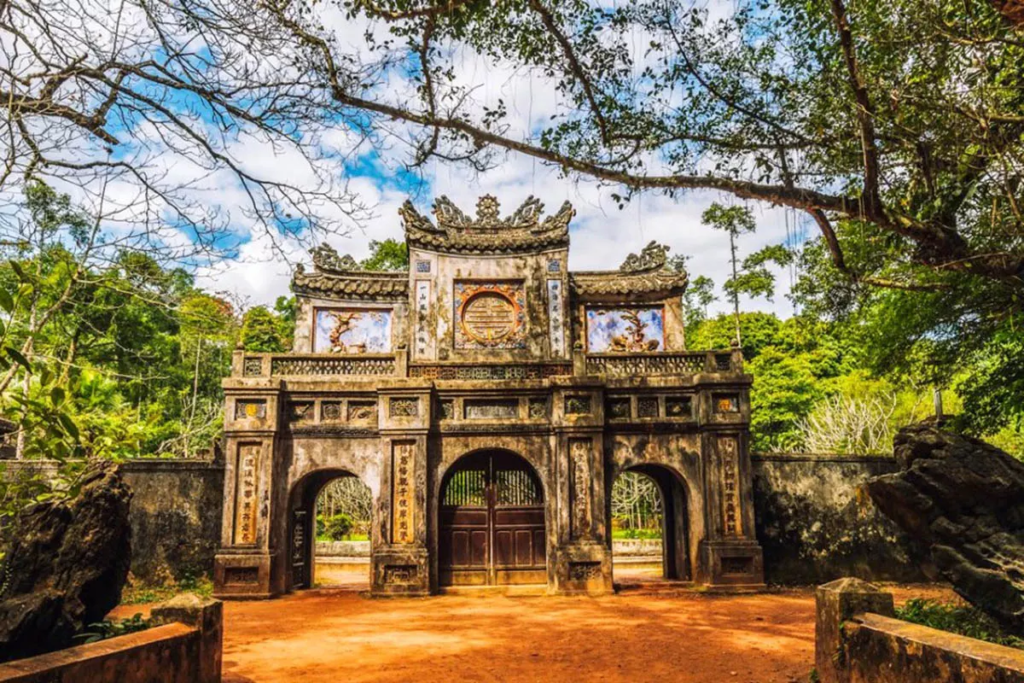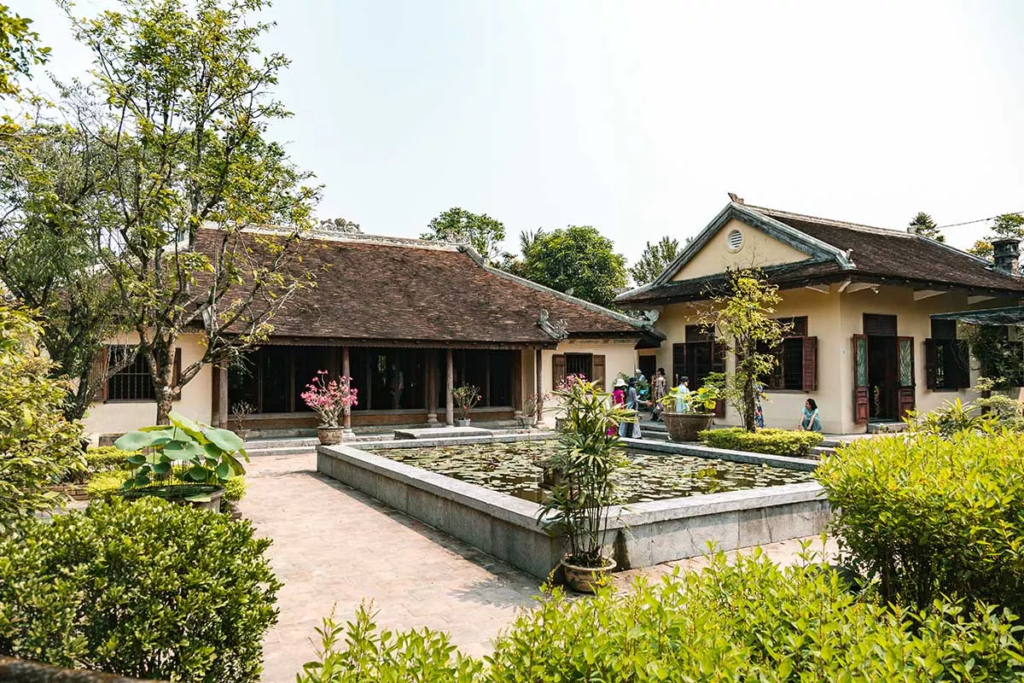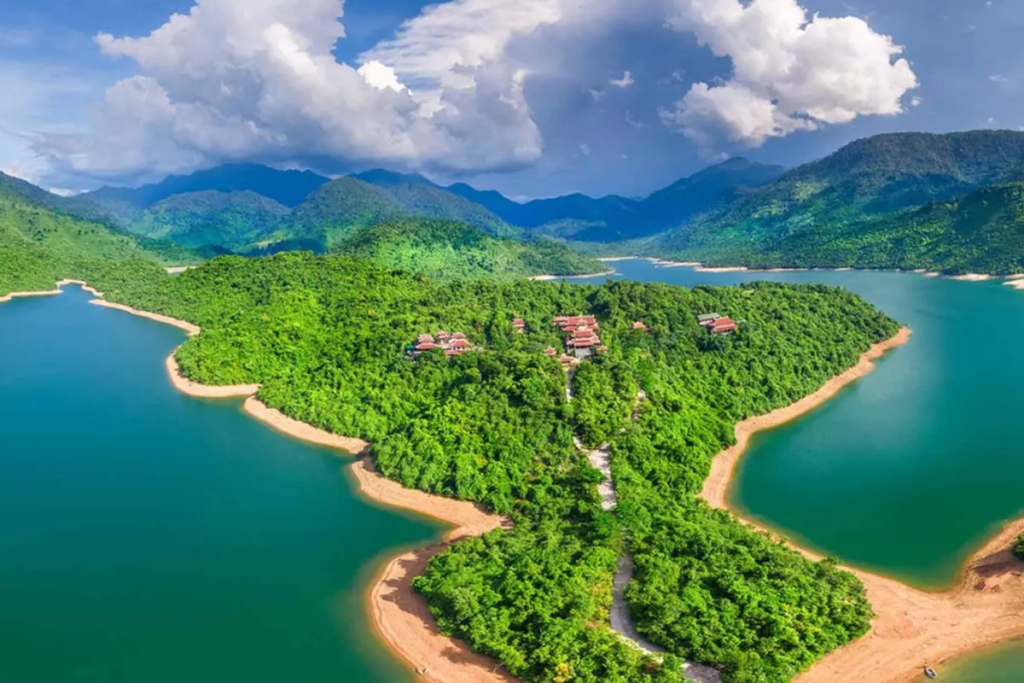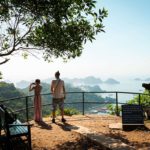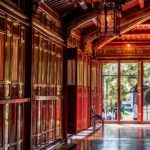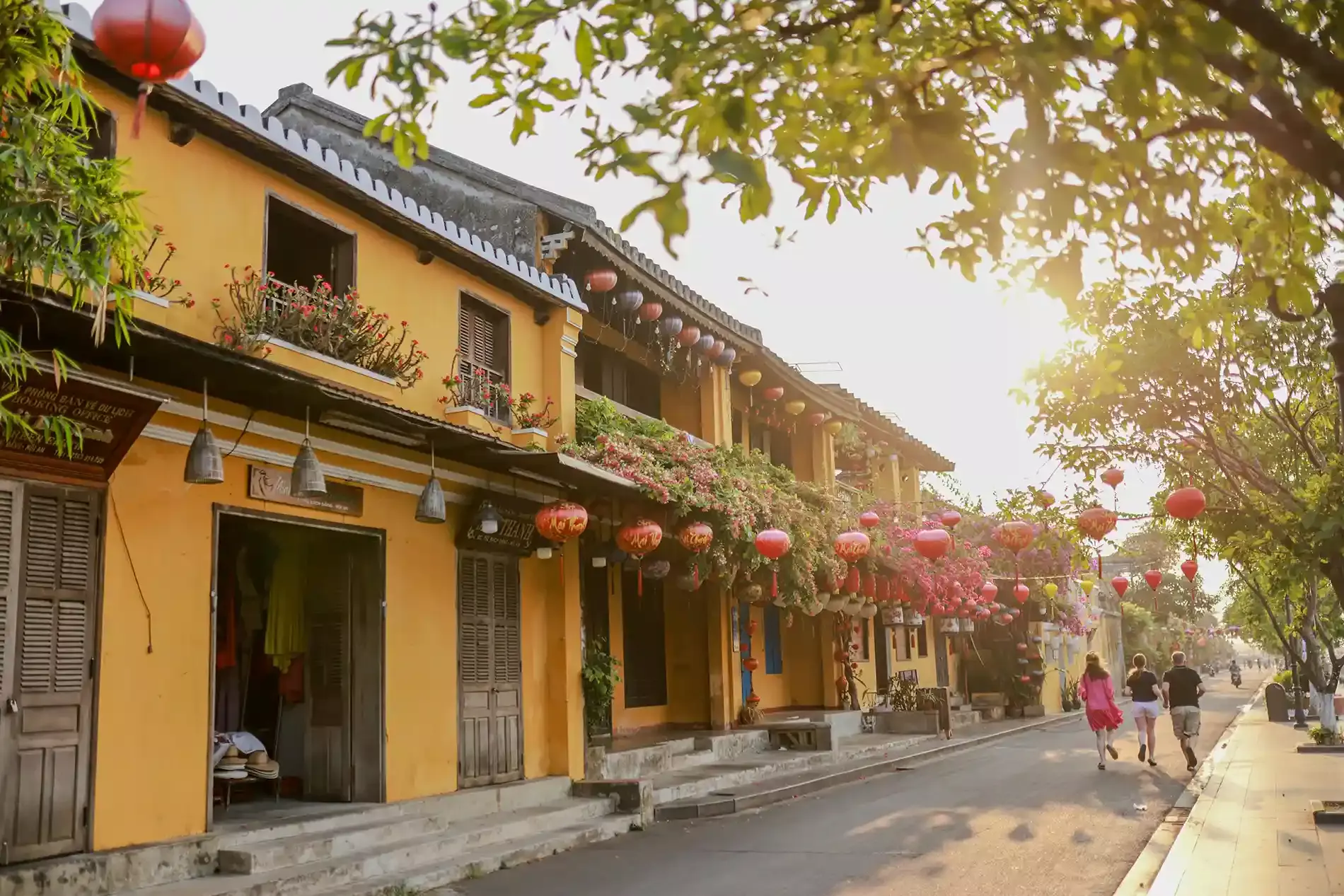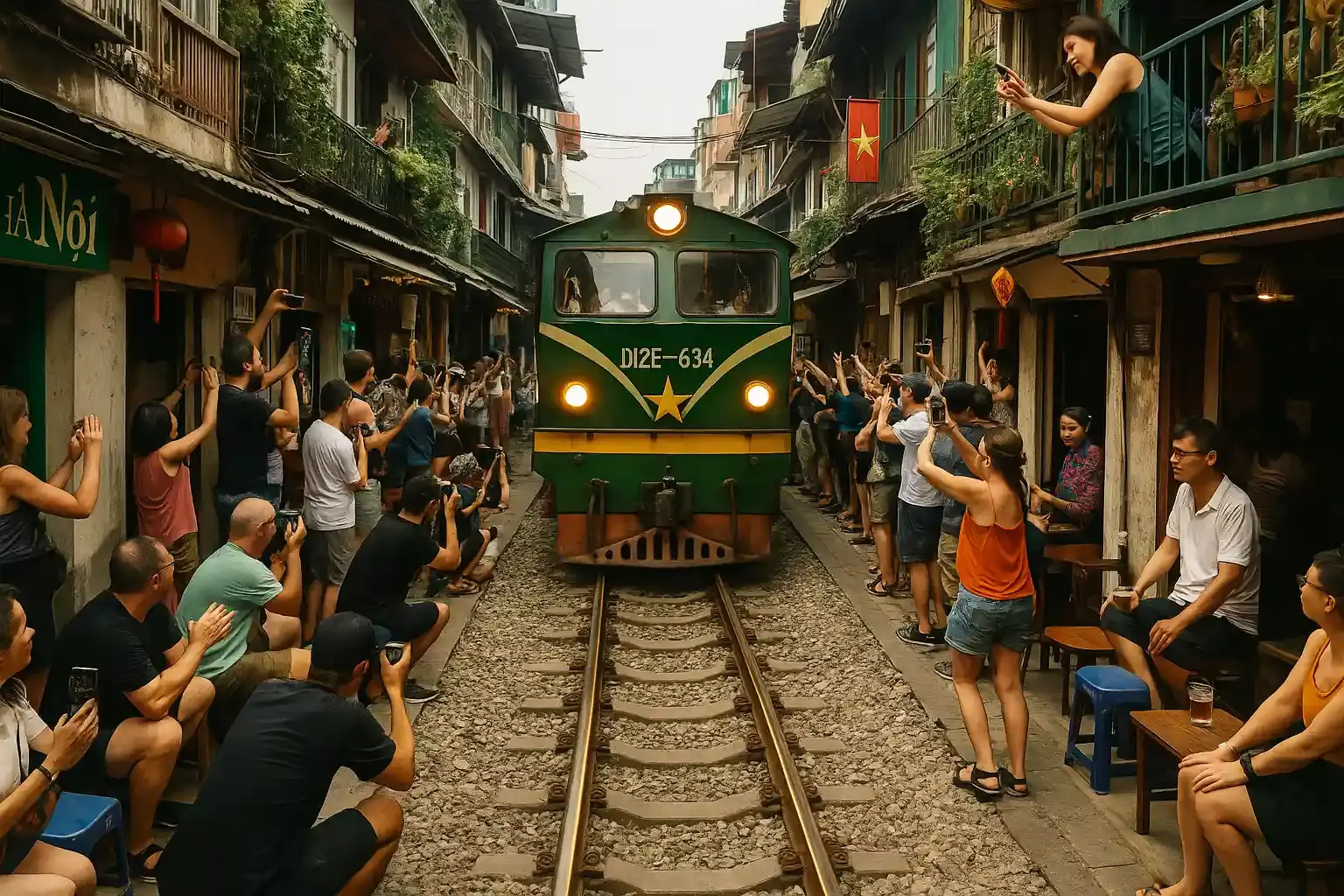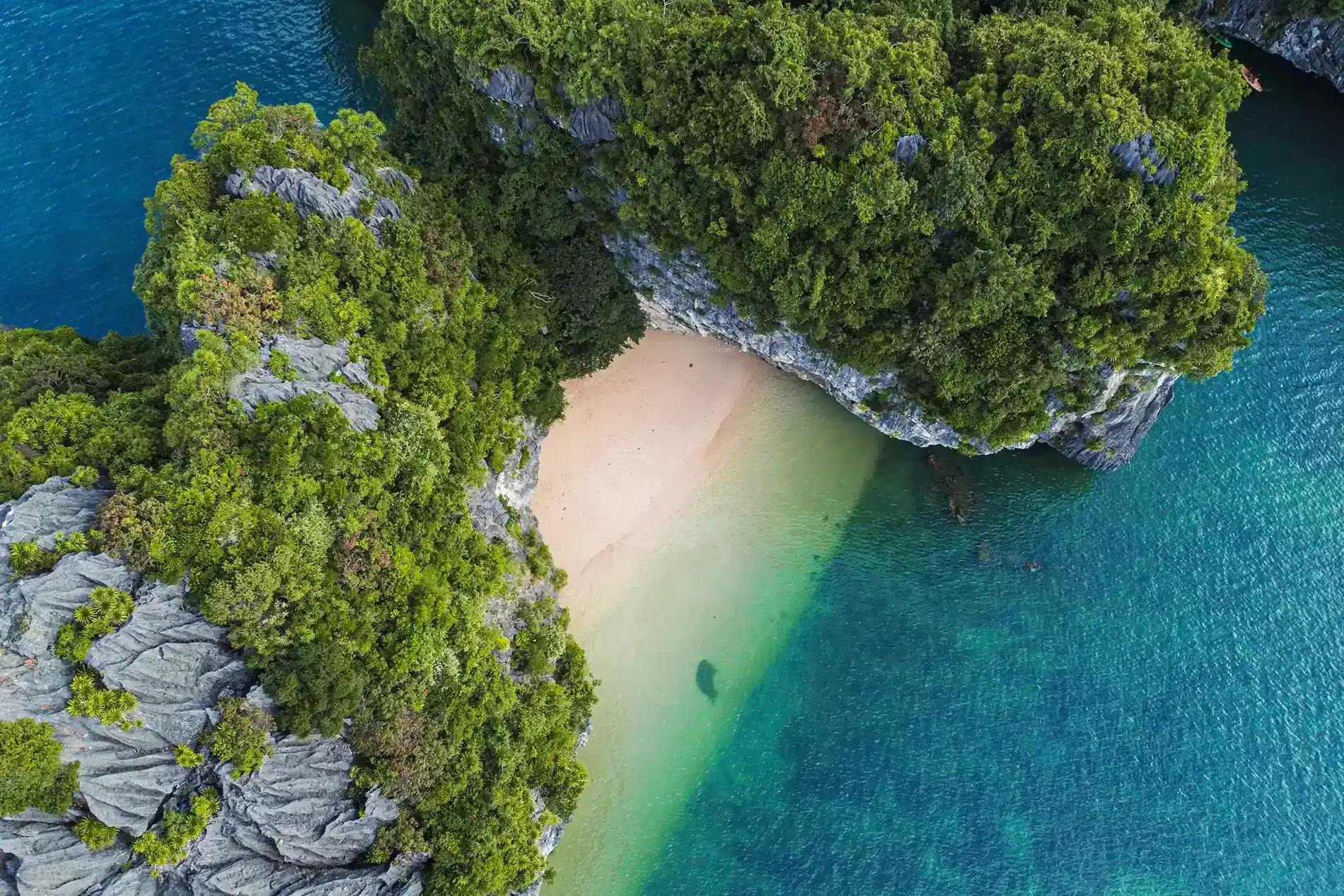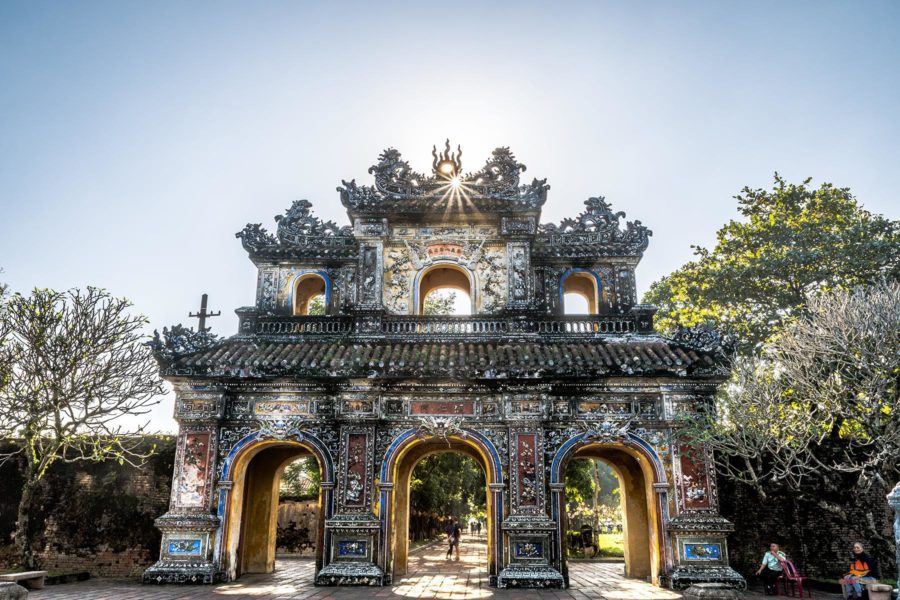
What to see in Hue, Vietnam? Top attractions and must-visit sites
Hue, located in the heart of Vietnam, is much more than just a city; it is a historical treasure that embodies the soul and cultural heritage of the country. Once the imperial capital of the Nguyen Dynasty, Hue was the political, religious, and cultural center of Vietnam for more than 140 years. This city, stretching along the picturesque Perfume River, is renowned for its exceptional architectural heritage, recognized as a UNESCO World Heritage Site.
Through its historical monuments, Hue tells the fascinating story of the Nguyen emperors and their court, reflecting the grandeur and refinement of this golden era. From the majestic Imperial City to the intricately carved royal tombs, ancient pagodas, and temples dedicated to deities and ancestors, every corner of the city offers a deep dive into a past rich in traditions and spirituality.
This article provides a detailed list of the main sites to visit in Hue, with in-depth descriptions that will help you not only plan your trip but also understand the historical and cultural significance of each place. Whether you’re a history enthusiast, an architecture lover, or simply a curious traveler, Hue will captivate you with the timeless beauty of its hidden treasures.
Table des matières de l'article
The imperial city of Hue
The noon gate (Ngo Mon)
The Noon Gate, or Ngo Mon, is much more than just an entrance to the Imperial City of Hue; it is the very symbol of Vietnamese imperial power. Built in 1833 during the reign of Emperor Minh Mang, this monumental structure stands out with its imposing three-level architecture. The gate’s five passages, with the central one exclusively reserved for the emperor, reflect the strict hierarchical order of the time. Flanked by two pavilions, the gate also served as a platform for official announcements and royal parades. The intricate carvings that adorn the gate feature traditional motifs such as dragons and phoenixes, symbols of power and prosperity. From the upper terrace, once reserved for the emperor and his dignitaries, visitors today can enjoy a panoramic view of the Imperial City, allowing them to fully appreciate the grandeur of this historic complex.
The Noon gate, Hue
The palace of supreme harmony (Thai Hoa)
The Palace of Supreme Harmony, the nerve center of the Imperial City, embodies the essence of authority and prestige of the Nguyen dynasty. Built in 1805 during the founding of Hue as the imperial capital, this palace served as the setting for the most important state ceremonies, such as coronations and diplomatic receptions. The palace’s roof, covered with yellow tiles, is reserved for royal buildings, highlighting the importance of this location. The red lacquered wooden columns, intricately carved and inlaid with gold, support this majestic structure. The interior is equally impressive, with the throne room adorned with frescoes and symbolic motifs representing cosmic harmony and the legitimacy of imperial power. Every detail, from the arrangement of the furniture to the wall decorations, reflects the attention to detail and refinement of the imperial court.
The Palace of Supreme Harmony, Hue
Temple of literature (Van Mieu)
The Temple of Literature in Hue, though less famous than its counterpart in Hanoi, holds a central place in the intellectual and spiritual life of the Imperial City. Dedicated to Confucius, this temple is not only a place of worship but also a center of learning where mandarins, the future high-ranking officials of the empire, received their education. The temple is a peaceful haven, with its shaded inner courtyards, well-kept gardens, and lotus ponds that create a serene atmosphere ideal for reflection. Visitors can admire stone steles engraved with the names of the imperial examination laureates, highlighting the importance placed on education and merit under the Nguyen dynasty. Every architectural detail, from the glazed tile roofs to the columns adorned with calligraphy, reflects the harmony between man and nature, a central concept in Confucian thought.
Entrance of the Temple of Literature
The palace of longevity (Dien Tho)
The Palace of Longevity, or Dien Tho, is a space of understated elegance, dedicated to the Queen Mother, a central figure in the imperial family. Unlike the more ostentatious buildings of the Imperial City, this palace was designed to offer comfort and tranquility to its resident. The complex is surrounded by lush gardens and serene ponds, symbolizing longevity and wisdom. Inside, the palace’s rooms are richly decorated, but in a subtle manner, with artworks depicting scenes of daily life and symbols of happiness and prosperity. The palace also houses a collection of gifts presented to the Queen Mother, illustrating diplomatic relations and family ties. Visitors here experience an atmosphere of peace and intimacy, in contrast to the formal grandeur of other buildings in the city.
Palace of Longevity, Hue
Royal tombs
Minh Mang tomb
Located about 12 kilometers from Hue on the western bank of the Perfume River, the Tomb of Minh Mang is a majestic testament to Vietnamese imperial architecture. Built between 1840 and 1843 during the reign of Emperor Minh Mang, this tomb is renowned for its perfect harmony with the surrounding nature. Designed according to the principles of feng shui, the complex subtly integrates natural elements such as hills, waterways, and forests to symbolize the union of heaven and earth. The site consists of 40 structures spread across a picturesque landscape, including pavilions, temples, gardens, and ponds. The main bridge, Trung Dao Bridge, crosses a crescent-shaped lake and leads to Minh Lau Pavilion, which offers panoramic views of the complex. This tomb not only represents the eternal rest of the emperor but also reflects his vision of the cosmos and social order, where harmony between man and nature is essential.
Minh Mang tomb, Hue
Tu Duc tomb
The Tomb of Tu Duc, located about 7 kilometers from the center of Hue, is considered one of the most sumptuous and elaborate of the royal tombs of the Nguyen dynasty. Built between 1864 and 1867 for Emperor Tu Duc, this complex was not only a burial site but also a royal retreat where the emperor spent time during his life. The site is surrounded by thick walls that protect a vast ensemble of lush gardens, elegant pavilions, temples dedicated to ancestors, and a large artificial lake called Luu Khiem. This lake, dotted with islets and bridges, adds to the peaceful and contemplative atmosphere of the place. The tomb itself is relatively modest compared to the overall complex, perhaps reflecting the melancholy and regrets of Emperor Tu Duc, whose life was marked by personal and political challenges. Visitors can stroll along the shaded pathways, admire the beauty of the gardens, and reflect on life and death in this serene environment.
Tu Duc tomb, Hue, Vietnam
Khai Dinh tomb
Located about 10 kilometers from Hue, on the steep slopes of Chau Chu Mountain, the Tomb of Khai Dinh is a unique masterpiece that reflects the fusion of Vietnamese and Western architectural influences. Built between 1920 and 1931 under the reign of Emperor Khai Dinh, this tomb stands out for its eclectic style, blending European Gothic elements with traditional Vietnamese architecture. Although smaller in size compared to those of his predecessors, the tomb is unparalleled in its ornamental richness. The entire complex is adorned with ceramic and glass mosaics, creating a dazzling visual effect, especially under the sunlight. The highlight of the visit is the throne room, where a bronze statue of Emperor Khai Dinh stands, surrounded by intricate murals and detailed sculptures depicting scenes from imperial life. This tomb, both bold and impressive, reflects a period of transition marked by the growing influence of the West in Vietnam.
Khai Dinh tomb, Hue
Pagodas and temples
Thien Mu pagoda
Perched on a picturesque hill overlooking the Perfume River, the Thien Mu Pagoda is much more than just a religious building; it is a true symbol of Hue and one of the most visited sites in Vietnam. Founded in 1601 by Lord Nguyen Hoang, the pagoda is associated with many legends and is deeply rooted in the cultural and religious history of the region. The name ‘Thien Mu’ means ‘Heavenly Lady,’ referring to an old prophecy in which a divine woman appeared on this hill, proclaiming that a lord would build a Buddhist temple to bring peace and prosperity.
The highlight of the pagoda is its seven-story octagonal tower, called Phuoc Duyen, erected in 1844 during the reign of Emperor Thieu Tri. This tower, the tallest of its kind in Vietnam, is dedicated to the Buddha and symbolizes the different reincarnations of Buddha. The pagoda itself is surrounded by beautiful gardens, lotus ponds, and ancient bonsai trees, providing a peaceful setting for meditation and prayer.
Inside the complex, visitors can discover an impressive collection of religious artifacts, including a large bronze bell called Dai Hong Chung, weighing over 2 tons, cast in 1710, and whose sound can be heard for miles around. The pagoda also houses an impressive statue of Maitreya Buddha, symbolizing happiness and benevolence, as well as numerous stone steles and inscriptions that recount the history and legends associated with this sacred site.
In addition to its architectural beauty, the Thien Mu Pagoda holds great spiritual and political significance. It was an active center of resistance against the French colonial regime and later against the Vietnam War. The Austin vehicle used by the monk Thich Quang Duc to travel to Saigon in 1963, where he self-immolated in protest against the persecution of Buddhists by the Ngo Dinh Diem regime, is displayed here, serving as a reminder of the pagoda’s role in modern Vietnamese history.
Aerial view of Thien Mu pagoda, Hue
Tu Hieu pagoda
Located about 5 kilometers from the center of Hue, Tu Hieu Pagoda is a haven of peace and serenity, nestled among wooded hills and surrounded by lush gardens. Founded in the mid-19th century, this pagoda is one of the most respected Buddhist monasteries in Hue, known for its fascinating history and unique spiritual atmosphere.
The pagoda was founded by Zen monk Thich Nhat Dinh, who, according to legend, had an exceptional devotion to his aging mother. He often left the monastery to care for her, leading to rumors among the other monks. When they discovered the truth, they were so moved by his filial piety that they helped build a temple to honor his acts. This temple became Tu Hieu Pagoda, whose name can be translated as ‘Filial Respect.’
The complex is built according to the principles of traditional Vietnamese Buddhist architecture, with curved roofs covered in glazed tiles, richly decorated gates, and elegant pavilions surrounded by gardens and lakes. The large lotus pond in front of the pagoda reflects the tranquility of this sacred place, while the Buddha statues and altars adorned with flowers and incense create an ambiance conducive to meditation.
Tu Hieu Pagoda is also known as the final resting place of many eunuchs from the royal court of the Nguyen dynasty, who chose this location for their burial due to its peace and beauty. The tombs, adorned with intricate carvings, are scattered throughout the gardens, adding an additional historical and cultural dimension to this already rich site.
Today, Tu Hieu Pagoda remains an active center of monastic life, with many monks living and studying there. It is also an important pilgrimage site for Buddhists and a must-see for visitors to Hue who seek to explore Vietnamese spirituality and culture. As visitors walk along its shaded paths, they can feel the profound tranquility of this place, a refuge from the chaos of the outside world.
Entrance of Tu Hieu pagoda, Hue
Bridges and markets
Trang Tien bridge
Trang Tien Bridge, also known as Truong Tien Bridge, is one of the most iconic symbols of the city of Hue, reflecting both its history and evolution. Built in 1899 during the reign of Emperor Thanh Thai, this metal bridge was designed by the French engineer Gustave Eiffel, famous for constructing the Eiffel Tower in Paris. Spanning 402 meters, the bridge was a marvel of engineering for its time and marked a turning point in the urban development of Hue.
Trang Tien Bridge connects the two banks of the Perfume River, a river that runs through the city and has played a crucial role in its development. It consists of six steel arches, supported by reinforced concrete pillars, and is a classic example of French colonial architecture combined with Vietnamese design elements. Each arch of the bridge is adorned with simple yet elegant geometric patterns that catch the eye of passersby.
This bridge is not only an architectural masterpiece but also a vibrant part of daily life for the people of Hue. During the day, it is bustling with the flow of motorcycles, bicycles, and pedestrians using it to cross the river. At night, the bridge transforms into a colorful light display, offering a striking visual spectacle reflected in the calm waters of the river. Visitors can stroll along the bridge, take in the breathtaking views of the city and surrounding mountains, and immerse themselves in the romantic atmosphere of Hue.
Trang Tien Bridge has also witnessed numerous historical events, including during the wars against French colonizers and later during the Vietnam War, where it was damaged and rebuilt multiple times. Today, it remains a symbol of resilience and continuity for the city of Hue, connecting not only two banks but also the past and present of this historic city.
Dong Ba market
Dong Ba Market is much more than just a commercial exchange; it is the beating heart of daily life in Hue and a vibrant testament to local culture. Founded in 1887 during the reign of Emperor Dong Khanh, Dong Ba Market is the largest and oldest market in Hue, sprawling over several hectares along the Perfume River. This market is a must-visit for anyone wishing to discover the soul of Hue, as it offers full immersion into the bustling local life.
The market is a maze of narrow aisles lined with hundreds of stalls brimming with all kinds of products. Fresh produce abounds: tropical fruits, green vegetables, aromatic herbs, and freshly caught fish, as well as exotic spices and essential ingredients for Vietnamese cuisine. The food stalls offer an impressive variety of local specialties, such as the famous ‘bun bo Hue’ (spicy noodle soup) and ‘banh khoai’ (crispy stuffed pancakes). It’s a true paradise for food lovers, who can sample the authentic flavors of Hue while observing locals going about their daily activities.
Dong Ba Market is also renowned for its local craftsmanship. Visitors can purchase traditional clothing, such as ‘ao dai’ (Vietnamese long dresses), made on-site by experienced seamstresses. You’ll also find conical hats, bamboo items, pottery, and many other handmade souvenirs that reflect the traditional craftsmanship of the region. The artisan stalls are an ideal place to find unique gifts to bring home.
What truly makes Dong Ba Market special is its atmosphere. The market is lively, noisy, and colorful, with vendors calling out to customers with warm smiles and negotiations taking place in a joyful buzz. It is a place where the past and present meet, where ancient traditions blend with modern life. As visitors stroll through the bustling aisles of the market, they can feel the pulse of Hue, a city that, despite the changes over the centuries, has managed to preserve its unique cultural identity.
Museums and traditional houses
Royal fine arts museum
Housed in one of the former imperial palaces, the Hue Museum of Royal Fine Arts is a true treasure for anyone interested in Vietnamese art, history, and culture. The museum is located within the grounds of the former Imperial City, adding an extra historical dimension to the visit, as the building itself is a remarkable example of Nguyen imperial architecture.
The museum houses an exceptional collection of artworks and artifacts that tell the rich and complex history of the Nguyen dynasty, Vietnam’s last imperial dynasty. Among the most precious pieces in the collection are sumptuous royal costumes, embroidered with gold and silver threads, worn by emperors, empresses, and high-ranking officials during grand court ceremonies. These costumes, with their intricate and symbolic motifs, reflect the refinement and elegance of the imperial court in Hue.
The museum also displays an extensive collection of fine porcelain, some of which were specially commissioned for the imperial court. These porcelains, often decorated with motifs of dragons, phoenixes, and landscapes, were used during royal banquets and are considered masterpieces of Vietnamese art. In addition to porcelain, the museum showcases traditional paintings, lacquered wood sculptures, and musical instruments, each offering a unique insight into the cultural life of the Hue court.
Another highlight of the museum is its collection of calligraphy and imperial poems, written by the emperors themselves. These literary works reveal the deep education and artistic sensibility of the Nguyen rulers, as well as their commitment to promoting the arts and culture. Visitors can also view personal items belonging to the emperors, such as royal seals, jewelry, and furniture, offering an intimate glimpse into daily life at the imperial court.
The Hue Museum of Royal Fine Arts is not just a display of artistic objects; it tells the story of an empire that flourished for over 140 years, leaving behind an invaluable cultural legacy. As visitors explore the museum’s halls, they are transported to a bygone era where art and culture were at the heart of imperial life.
Hue Museum of Royal Fine Arts
An Hien garden-house
Nestled in a peaceful garden a few kilometers from the center of Hue, An Hien Garden House is one of the finest examples of traditional Vietnamese architecture. Built in the late 19th century, this house was once the residence of a mandarin of the imperial court and has retained all its former charm.
An Hien House is a model of harmony between architecture and nature, a central concept in Vietnamese philosophy. Upon entering the property, visitors are greeted by an ornate gate that opens onto a path lined with hedges and exotic plants, leading to the main house. This alley, designed to calm the mind and prepare visitors for the serene ambiance of the house, is itself an introduction to the Vietnamese art of living.
The house is built according to the principles of feng shui, with carefully chosen orientation and layout to maximize the flow of positive energy. The curved tiled roofs, supported by finely carved solid wood columns, create an elegant silhouette that blends seamlessly into the surrounding landscape. The interior of the house is equally impressive, featuring antique lacquered wooden furniture, delicate screens, and family altars adorned with porcelain vases and candles. Every room in the house is arranged to reflect the respect for traditions and the refined lifestyle of noble families of the time.
The garden surrounding the house is a true haven of peace. It is designed as a contemplative garden, with lotus ponds, fruit trees, and tropical flowers that fill the air with their delicate fragrances. Visitors can stroll through the garden, sit in the shade of a centuries-old tree, and feel the tranquility that emanates from this place. The garden is also populated by songbirds and koi fish, adding to the serene and meditative atmosphere.
An Hien Garden House is not just a tourist site; it is a living testimony to the culture and traditions of Hue. By visiting this house, visitors can learn how mandarins and their families lived in harmony with nature, while honoring customs and rituals passed down through generations. It is a place where the past and present meet, offering a rare glimpse into the aristocratic lifestyle of Vietnam’s bygone era.
An Hiên garden-house, Hue
Around Hue
Thuan An beach
Located about 15 kilometers from the center of Hue, Thuan An Beach is an ideal destination for those looking to relax and enjoy the sea. With its fine sand and clear waters, this beach is perfect for swimming, sunbathing, and water sports. Visitors can also enjoy fresh seafood at the local restaurants along the beach.
Bach Ma National Park
Bach Ma National Park, located about 40 kilometers south of Hue, is a nature reserve offering exceptional biodiversity and breathtaking landscapes. Hiking and nature enthusiasts can explore the trails of Bach Ma Mountain, admire waterfalls, and observe the local wildlife and flora. The park also provides panoramic views of the coast and surrounding mountains.
Bach Ma national park
Hue, with its rich historical and cultural heritage, is a must-visit destination for travelers in Vietnam. Whether you’re passionate about history, a culture enthusiast, or simply seeking natural beauty, Hue offers a unique and memorable experience. By exploring its ancient monuments, peaceful pagodas, bustling markets, and beautiful surroundings, you will discover the soul of Vietnam’s former imperial capital.
Enjoy your visit!
Sorry, the comment form is closed at this time.

